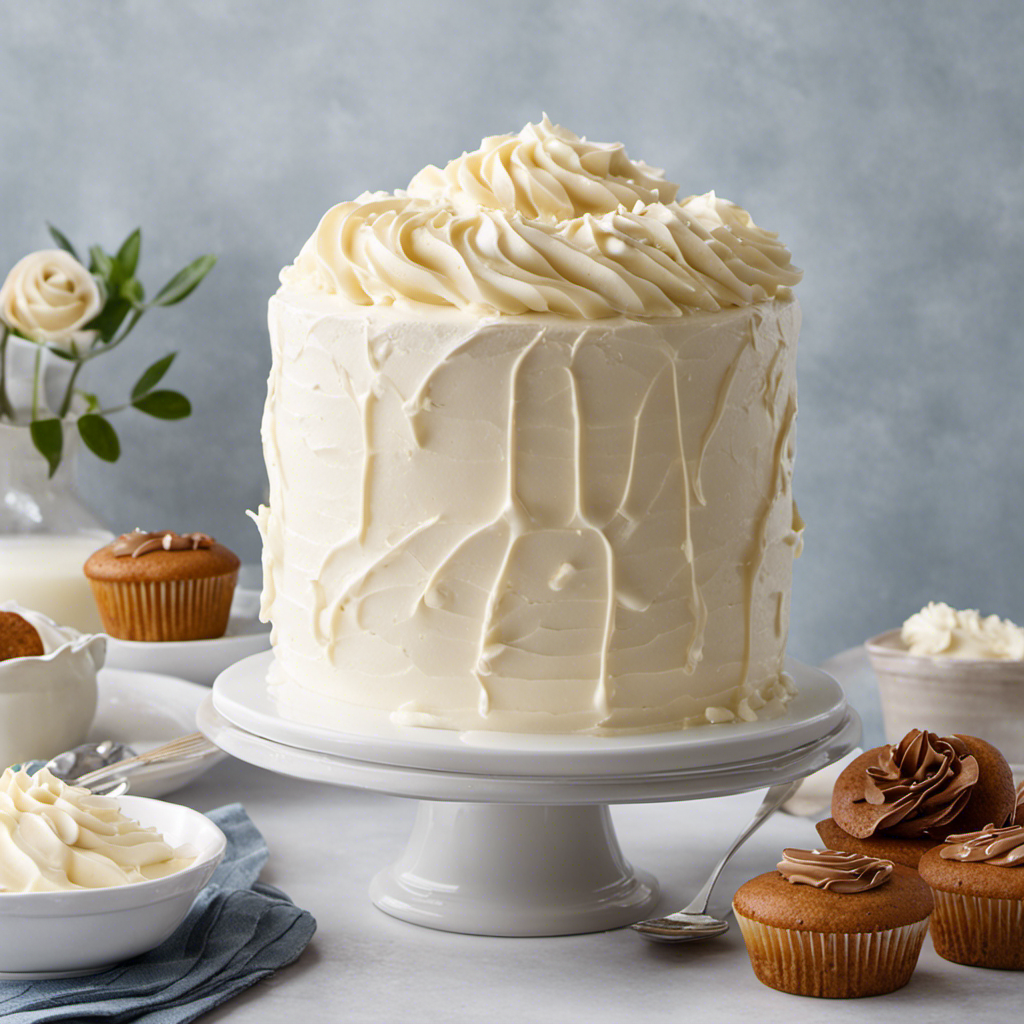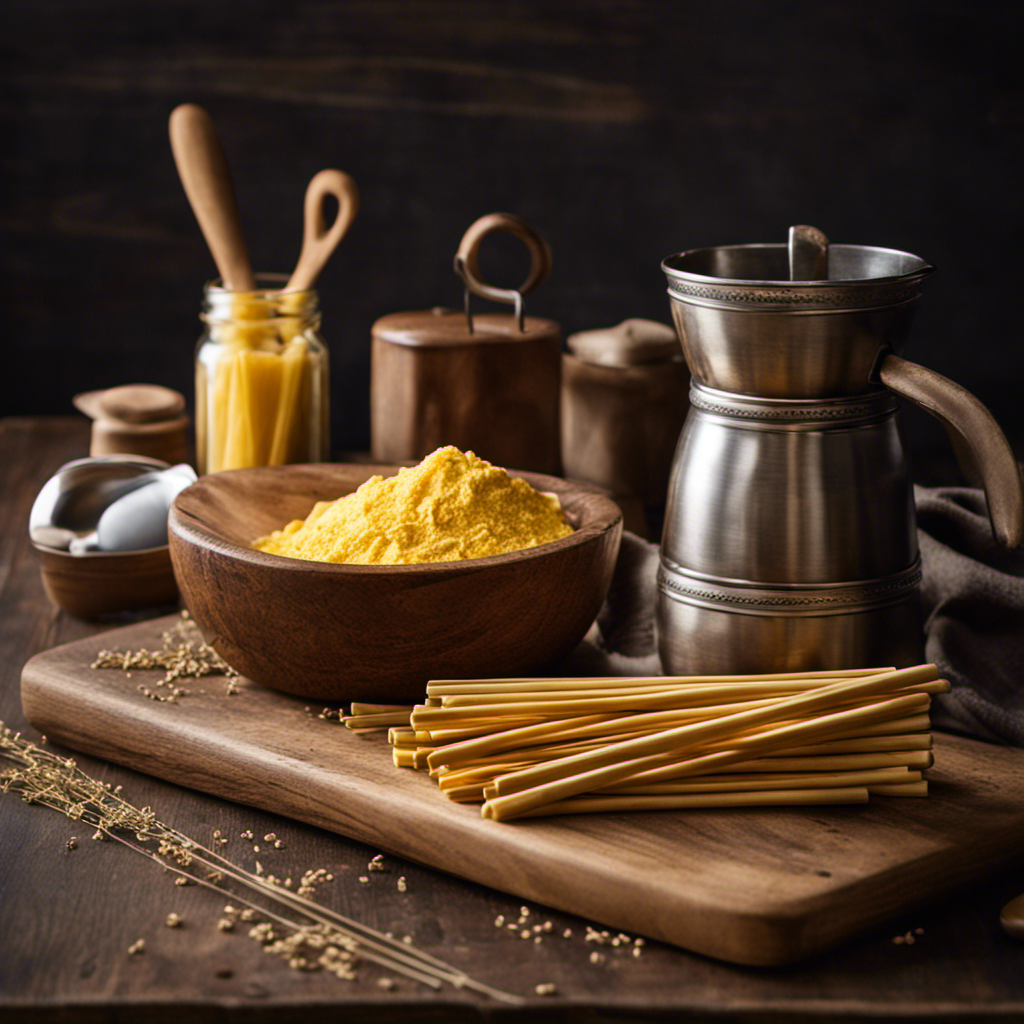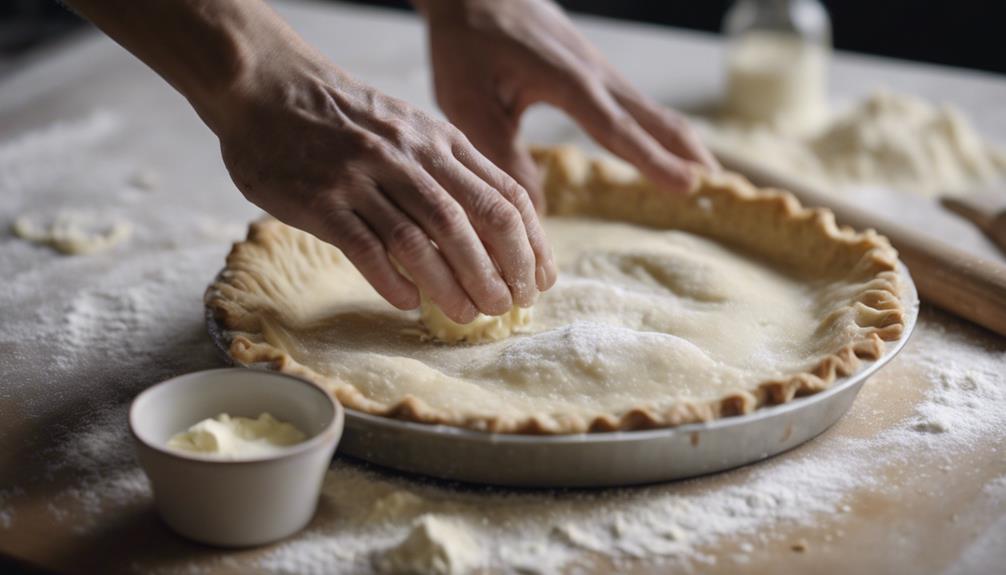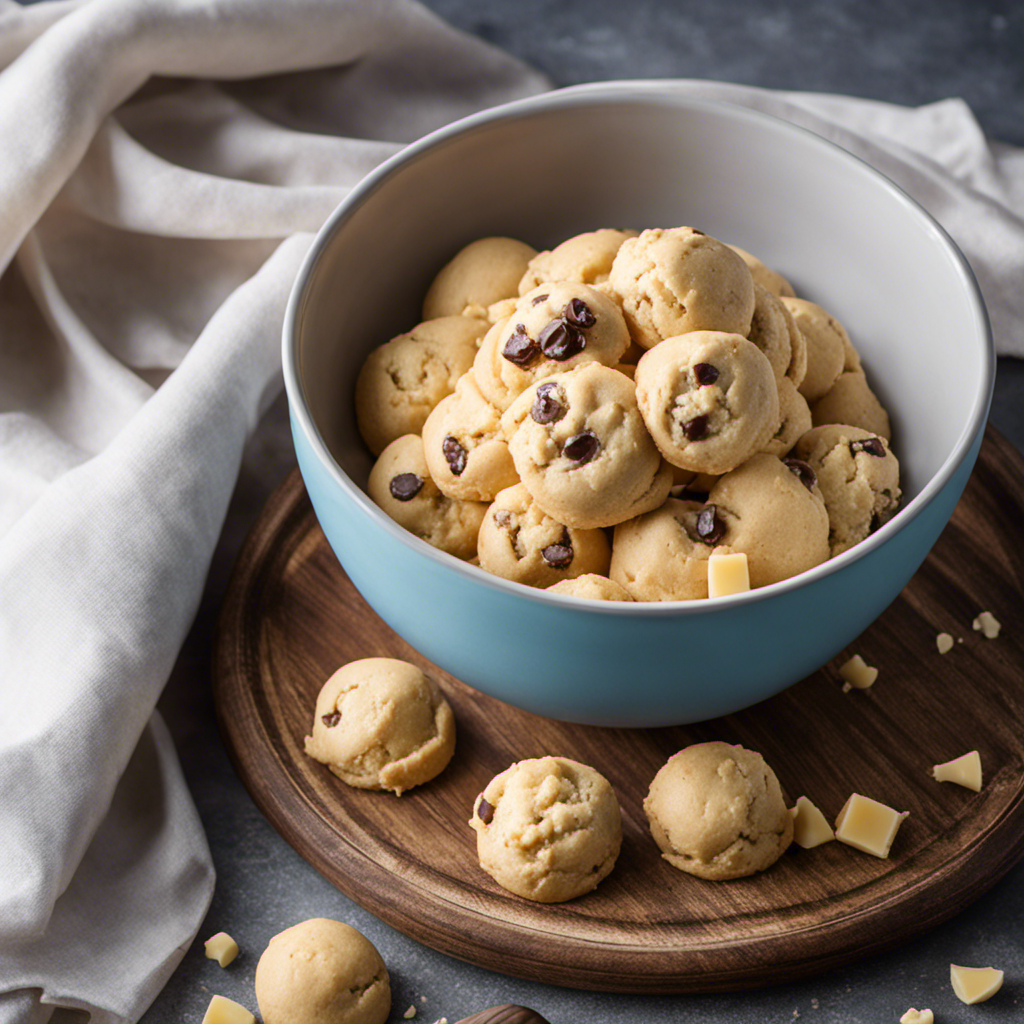I’ve always been puzzled by the question of how many cups are in 4 ounces of butter. It appears to be a straightforward inquiry, yet the solution has always escaped me.
Well, fear not, my fellow bakers! In this article, I will guide you through the basics of converting ounces to cups and provide you with the standard measurements for butter.
Get ready to conquer the kitchen with accuracy and precision as we uncover the secret to measuring butter perfectly every time.
Key Takeaways
- Accurate measurements are crucial in baking and cooking to ensure consistency in taste and texture.
- Conversion techniques, such as using the right tools and consulting conversion charts, help in accurately measuring ingredients.
- Understanding measurement equivalents, such as 1 cup equals 8 ounces, is important for converting ingredients like butter.
- Using a kitchen scale or measuring cups, and consulting conversion charts, can help measure butter accurately.
Understanding the Basics
Understanding the basics of measuring ingredients is essential for knowing how many cups are in an ounce of butter. When it comes to converting grams to cups, accuracy is key.
To measure ingredients accurately, it is important to have the right tools, such as measuring cups and spoons. Start by scooping the butter into the measuring cup and leveling it off with a straight edge. Be precise in measuring, as even a slight difference can affect the final outcome of your recipe.
Keep in mind that different ingredients have different densities, so the conversion from grams to cups may vary. It’s always a good idea to consult a reliable conversion chart or use a kitchen scale for more precise measurements.
Converting Ounces to Cups
To convert ounces to cups, you can easily figure out how much butter is needed. Here’s a simple guide to help you with converting ounces to cups:
- Understand the conversion factor: 1 cup is equal to 8 ounces.
- Calculate the number of cups: Divide the number of ounces by 8.
- Round off the result: If the conversion is not an exact number, round it to the nearest decimal place.
Converting ounces to grams can also be useful when estimating butter measurements. 1 ounce is equal to approximately 28 grams. This conversion can be helpful when following recipes that provide butter measurements in grams instead of ounces.
Now that you know how to convert ounces to cups and grams, let’s move on to explore standard measurements for butter.
Standard Measurements for Butter
When baking, you can easily measure butter using standard measurements like sticks or tablespoons. Understanding measurements is crucial in achieving the perfect balance of ingredients in your recipes.
One common measuring mistake is using the wrong unit of measurement. For example, if a recipe calls for 1 cup of butter and you mistakenly measure it in tablespoons, your final product may turn out too greasy or dry.
Another mistake is not properly measuring butter that comes in sticks. Each stick of butter is typically equal to 1/2 cup or 8 tablespoons. So if a recipe calls for 1 cup of butter, you would need 2 sticks.
The Importance of Accuracy
Make sure you’re precise with your measurements when baking to achieve the perfect balance of ingredients in your recipes. The importance of precision cannot be overstated when it comes to baking. Even a slight variation in the amount of an ingredient can have a significant impact on the final result.
Here are three reasons why accuracy is crucial:
-
Consistency: Precise measurements ensure that you consistently achieve the desired taste and texture in your baked goods.
-
Chemistry: Baking is a science, and accurate measurements are essential for the chemical reactions that occur during the baking process to occur properly.
-
Texture: Inaccurate measurements can lead to dry, dense, or overly moist baked goods, affecting their overall quality.
It is crucial to note that inaccurate measurements can ruin an entire batch of baked goods. So, remember to use measuring cups and spoons and follow the recipe meticulously to avoid any mishaps.
Now, let’s move on to calculating the conversion ratio.
Calculating the Conversion Ratio
Calculating the conversion ratio can be a useful tool for adjusting recipes to different serving sizes. When it comes to cooking, precise measurements are crucial for accurate results. Understanding measurement equivalents is key to converting ingredients from one unit to another.
For example, if a recipe calls for 8 ounces of butter and you want to know how many cups that is, you can use the conversion ratio. One cup is equivalent to 8 ounces, so in this case, 8 ounces of butter would be 1 cup.
To ensure accurate conversions, it’s important to use reliable conversion charts or online tools. Additionally, always double-check your calculations to avoid any errors.
Handy Measurement Equivalents
Now that we’ve learned about calculating the conversion ratio, let’s dive into some handy measurement equivalents. Understanding measurement units is crucial when converting grams to cups. Here are three key equivalents to keep in mind:
-
1 cup of water weighs approximately 240 grams. This is a useful reference point when converting grams to cups.
-
1 stick of butter is equal to half a cup or 113 grams. This can be helpful when a recipe calls for butter in cups and you only have it in grams.
-
1 cup of all-purpose flour weighs around 125 grams. This can be handy when you’re working with a recipe that provides measurements in grams and you prefer to use cups.
Tips for Measuring Butter
Measuring butter can be made simpler by using the conversion ratio of 1 stick being equal to half a cup or 113 grams. When it comes to measuring techniques, it’s important to be precise.
Start by unwrapping the butter and using a sharp knife to cut it into even slices or cubes. This will ensure accurate measurements.
If you don’t have a scale, you can use measuring cups. Fill a liquid measuring cup with water and add the desired amount of butter until the water level rises to the desired measurement. Be sure to use a clear measuring cup for better visibility.
If you’re looking for butter substitutes, options like coconut oil or margarine can be used, but be aware that they may affect the taste and texture of your recipe.
Common Mistakes to Avoid
When it comes to baking, understanding cup measurements and butter conversions is crucial. Knowing how to convert ounces of butter into cups can make a big difference in the final outcome of your recipe.
In this discussion, I will explain the proper measurements for butter and provide tips on understanding cup measurements, ensuring your baking endeavors are accurate and successful.
Butter Measurement Conversions
To convert ounces of butter to cups, you’ll need to know the measurement conversion. Here are some tips for accurate measurement and butter measurement equivalents:
-
Use a kitchen scale: Weighing the butter is the most accurate method. 1 ounce of butter is equal to 0.125 cups.
-
Use measuring cups: If you don’t have a scale, you can use measuring cups. 1 cup of butter is equal to 8 ounces.
-
Refer to a conversion chart: There are many conversion charts available online that provide accurate measurements for butter and other ingredients.
Understanding cup measurements is essential for precise baking and cooking. Now that you know how to convert ounces of butter to cups, let’s dive into understanding cup measurements in more detail.
Understanding Cup Measurements
Understanding cup measurements is crucial for precise baking and cooking, so it’s helpful to have a conversion chart on hand. When it comes to measuring techniques, it’s important to know the different units and how they relate to each other. To make it easier for you, here is a handy conversion table:
| Cups (c) | Fluid Ounces (fl oz) | Milliliters (ml) |
|---|---|---|
| 1 | 8 | 237 |
| 1/2 | 4 | 118 |
| 1/4 | 2 | 59 |
With this table, you can easily convert between cups, fluid ounces, and milliliters. Whether you’re following a recipe or experimenting with your own creations, having a good understanding of cup measurements will ensure accurate results. So next time you’re in the kitchen, refer to this chart and cook with confidence.
Practical Application in Recipes
When it comes to cooking and baking, accurate measurements are crucial for successful results. In this discussion, I’ll be sharing some conversion tips that will help you achieve precision in your recipes.
Additionally, I’ll explain common recipe measurements, such as the difference between teaspoons and tablespoons, to ensure you have a clear understanding of each measurement unit.
Conversion Tips for Accuracy
If you’re unsure about the conversion from ounces of butter to cups, remember that using a kitchen scale will give you the most accurate results. When it comes to converting measurements in the kitchen, precision is key.
Here are three conversion techniques that can help you achieve accurate measurements:
-
Use a kitchen scale: Weighing the butter in ounces will give you the most precise measurement. Simply place your container on the scale, zero it out, and then add the desired amount of butter until you reach the desired weight.
-
Use a conversion chart: Many cooking websites and apps provide conversion charts that can help you convert ounces to cups. These charts are handy references that take the guesswork out of your measurements.
-
Use measuring spoons: If you don’t have a kitchen scale, you can use measuring spoons to convert ounces to cups. For example, 1 ounce of butter is equal to 2 tablespoons or 1/8 cup.
Common Recipe Measurements Explained
When it comes to recipe measurements, it’s important to understand the difference between cups and tablespoons, as well as measuring liquid versus dry ingredients.
Cups are typically used to measure larger quantities of both liquid and dry ingredients. They are commonly used for measuring flour, sugar, and liquids like milk or water.
On the other hand, tablespoons are used for smaller quantities of ingredients, such as spices, extracts, or oils.
When measuring liquid ingredients, it’s important to use a liquid measuring cup with clear markings on the side for accurate measurements.
Dry ingredients, on the other hand, should be measured using dry measuring cups, which allow you to level off the excess with a straight edge for precision.
Frequently Asked Questions
Can I Use Margarine Instead of Butter in Recipes?
Yes, you can use margarine instead of butter in recipes. Margarine has health benefits like being lower in saturated fat. To substitute, use the same amount of margarine as the butter called for in the recipe.
How Do I Measure Butter if I Don’t Have a Measuring Cup?
To measure butter without a cup, you can use the markings on the wrapper or a kitchen scale. Another option is to compare the size of the butter to common household items like a ping pong ball or a deck of cards.
Can I Use Oil Instead of Butter in Recipes?
Yes, you can substitute oil for butter in recipes. The pros of using oil include a moist texture and a longer shelf life. However, oil may alter the taste and texture of the final product. Other alternative ingredients for baking without butter include applesauce and mashed bananas.
How Can I Soften Butter Quickly for Baking?
To soften butter quickly for baking, there are a few ways you can try. One method is to cut it into small pieces and let it sit at room temperature for about 30 minutes. Another option is to microwave it for 5-10 seconds at a time until soft but not melted. Remember, the best temperature for softened butter in baking is around 65-70°F.
Is It Necessary to Use Unsalted Butter in Recipes?
Is it necessary to use unsalted butter in recipes? When it comes to baking, unsalted butter is preferred because it allows better control over the salt content. It plays a crucial role in enhancing flavors and creating a tender texture.
Conclusion
So there you have it, 4 ounces of butter is equal to half a cup.
It’s important to remember that accuracy is key when measuring ingredients for your recipes.
Using the right conversion ratio ensures that your dishes turn out just right.
As the saying goes, ‘Measure twice, cut once.’
So take your time, follow the tips for measuring butter, and avoid common mistakes.
With this knowledge, you’ll be able to confidently incorporate butter into your recipes and create delicious dishes every time.










